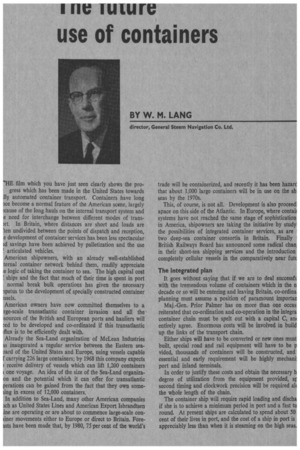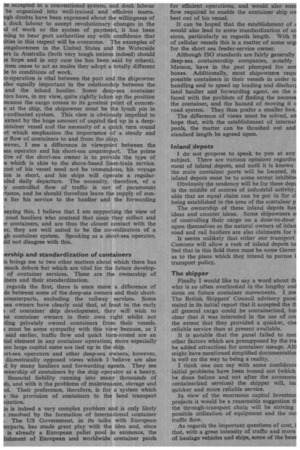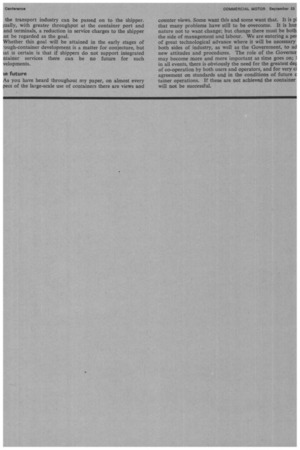I nu TuLure
Page 172

Page 173

Page 174

If you've noticed an error in this article please click here to report it so we can fix it.
use of containers
BY W. M. LANG
director, General Steam Navigation Co. Ltd.
"HE film which you have just seen clearly shows the progress which has been made in the United States towards fly automated container transport. Containers have long ice become a normal feature of the American scene, largely ;cause of the long hauls on the internal transport system and e need for interchange between different modes of trans)rt. In Britain, where distances are short and loads are ten undivided between the points of dispatch and reception, e development of container services has been less spectacular id savings have been achieved by palletization and the use articulated vehicles.
American shipowners, with an already well-established ternal container network behind them, readily appreciate Le logic of taking the container to sea. The high capital cost ships and the fact that much of their time is spent in port normal break bulk operations has given the necessary ipetus to the development of specially constructed container American owners have now committed themselves to a rge-scale transatlantic container invasion and all the ;sources of the British and European ports and hauliers will ed to be developed and co-ordinated if this transatlantic ;flux is to be efficiently dealt with.
Already the Sea-Land organization of McLean Industries as inaugurated a regular service between the Eastern seacard of the United States and Europe, using vessels capable I carrying 226 large containers; by 1968 this company expects ; receive delivery of vessels which can lift 1,200 containers one voyage. An idea of the size of the Sea-Land organizaon and the potential which it can offer for transatlantic perations can be gained from the fact that they own someling in excess of 12,000 containers.
In addition to Sea-Land, many other American companies ach as United States Lines and American Export Isbrandtsen inc are operating or are about to commence large-scale confiner movements either to Europe or direct to Britain. Foreasts have been made that, by 1980, 75 per cent of the world's trade will be containerized, and recently it has been hazarc that about 1,000 large containers will be in use on the sh seas by the 1970s.
This, of course, is not all. Development is also proceed apace on this side of the Atlantic. In Europe, where contait systems have not reached the same stage of sophistication in America, shipowners are taking the initiative by study the possibilities of integrated container services, as are two deep-sea container consortia in Britain. Finally British Railways Board has announced some radical chan, in their short-sea shipping services and the introduction completely cellular vessels in the comparatively near futt
The integrated plan It goes without saying that if we are to deal successft with the tremendous volume of containers which in the n decade or so will be entering and leaving Britain, co-ordina planning must assume a position of paramount importan Maj.-Gen. Prior Palmer has on more than one occas reiterated that co-ordination and co-operation in the integra container chain must be spelt out with a capital C, am entirely agree. Enormous costs will be involved in build up the links of the transport chain.
Either ships will have to be converted or new ones must built, special road and rail equipment will have to be p vided, thousands of containers will be constructed, and essential and early requirement will be highly rnechani: port and inland terminals.
In order to justify these costs and obtain the necessary h degree of utilization from the equipment provided, sr second timing and clockwork precision will be required ah the whole length of the chain.
The container ship will require rapid loading and discha if she is to achieve a minimum period in port and a fast tu round. At present ships are calculated to spend about 50 cent of their lives in port, and the cost of a ship in port is• appreciably less than when it is steaming on the high seas, .te accepted in a conventional system, and dock labour be organized into well-trained and efficient teams. ugh doubts have been expressed about the willingness of dock labour to accept revolutionary changes in the KI of work or the system of payment, it has been !ning to hear port authorities say with confidence that ilties in this respect will be overcome. The examples of .ongshoremen in the United States and the Waterside ers in Australia (both very tough unions indeed) should is hope and in any case (as has been said by others), men cease to act as mules they adopt a totally different ie to conditions of work.
:o-operation is vital between the port and the shipowner also equally important in the relationship between the and the inland haulier. Some deep-sea container tors have, in my view, quite rightly taken up the position recause the cargo comes to its greatest point of concenn at the ship, the shipowner must be the lynch pin in 3-ordinated system. This view is obviously impelled to extent by the huge amount of capital tied up in a deepontainer vessel and the necessity of a quick turn round In which emphasizes the importance of a steady and ir flow of containers to and from the ship.
wever, I see a difference in viewpoint between the sea operator and his short-sea counterpart. The prime five of the short-sea owner is to provide the type of :e which is akin to the shore-based liner-train service. zost of his vessel need not be tremendous, his voyage ion is short, and his ships will operate a regularWed daily departure. The necessity, therefore, of a Iy controlled flow of traffic is not of paramount rtance, and he should therefore leave the supply of cons for his service to the haulier and the forwarding saying this, I believe that I am supporting the view of road hauliers who contend that since they collect and containers, and are thus the closest contact with the er, they are well suited to be the co-ordinators of a gh container system. Speaking as a short-sea operator, rid not disagree with this.
iership and standardization of containers is brings me to two other matters about which there has much debate but which are vital for the future developof container services. These are the ownership of iners and their standardization.
regards the first, there is once more a difference of de between some of the deep-sea owners and their shortcounterparts, excluding the railway services. Some sea owners have clearly said that, at least in the early s of container ship development, they will wish to ne container owners in their own right whilst not ding privately owned containers from their vessels. 3 must be some sympathy with this view because, as I said earlier, traffic flow and quick turn-round are an tial clement in any container operation; more especially len large capital sums are tied up in the ship.
ort-sea operators and other deep-sea owners, however, diametrically opposed views which I believe are also d by many hauliers and forwarding agents. They see wnership of containers by the ship operator as a heavy, financial liability running into many thousands of ds, and with it the problems of maintenance, storage and ol. Their preference, therefore, is for a system which s the provision of containers to the land transport rization.
is is indeed a very complex problem and is only likely resolved by the formation of international container The US Government, in its talks with European terparts, has made great play with the idea and, since is already a European pallet pool in existence, the lishment of European and worldwide container pools for efficient operations, and would also ensu flow required to enable the container ship oss best out of his vessel.
It can be hoped that the establishment of c would also lead to some standardization of co sions, particularly as regards length. With ti of cellular vessels this is a matter of some urgi for the short sea feeder-service owner.
Although ISO standards are fairly generally deep-sea containership companies, notably Matson, have in the past plumped for nor boxes. Additionally, most shipowners requi possible containers in their vessels in order to handling and to speed up loading and dischar land haulier and forwarding agent, on the a faced with the problem of finding the necessa the container, and the hazard of moving it c road system. They thus prefer a smaller box.
The difference of views must be solved, an hope that, with the establishment of internat pools, the matter can be thrashed out and standard length be agreed upon.
Inland 'depots
I do not propose to speak to you at any subject. There are various opinions regardin. ment of inland depots, and until it is known the main container ports will be located, th inland depots must be to some extent inhibitec Obviously the tendency will be for these dept in the middle of centres of industrial activity; able that an equal claim can be put in for cl being established in the area of the container p The ownership of these inland depots has ideas and counter ideas. Some shipowners sc of controlling their cargo on a door-to-door upon themselves as the natural owners of inlan road and rail hauliers are also claimants for ti It seems unlikely that either our transport Customs will allow a rash of inland depots to feel that in this field there must be some Gover as to the plans which they intend to pursue i transport policy.
The shipper Finally I would like to say a word about th who is so often overlooked in the lengthy and sions on future container movements. I me The British Shippers' Council advisory panel stated in its initial report that it accepted the tt all general cargo could be containerized, bui clear that it was interested in the use of cor the extent that they provided a quicker, che reliable service than at present available.
It is notable that the panel failed to men other factors which are presupposed by the tra be added attractions for container useage. Alt] might have mentioned simplified documentatior is well on the way to being a reality.
I think one can say with some confidence initial problems have been ironed out (which be done before and not after the commene containerized services) the shipper will, inc quicker and more reliable service.
In view of the enormous capital investme projects it would be a reasonable suggestion ti the through-transport chain will be striving possible utilization of equipment and the mo traffic flow.
As regards the important questions of cost, i that, with a great intensity of traffic and more of haulage vehicles and ships, some of the bene the transport industry can be passed on to the shipper. lually, with greater throughput at the container port and and terminals, a reduction in service charges to the shipper 1st be regarded as the goal.
Whether this goal will he attained in the early stages of .ough-container development is a matter for conjecture, but tat is certain is that if shippers do not support integrated ntainer services there can be no future for such velopments.
le future As you have heard throughout my paper, on almost every pect of the large-scale use of containers there are views and counter views. Some want this and some want that. It is pl that many problems have still to be overcome. It is hue nature not to want change; but change there must be both the side of management and labour. We are entering a per of great technological advance where it will be necessary both sides of industry, as well as the Government, to ad new attitudes and procedures. The role of the Governtr may become more and more important as time goes on; I in all events, there is obviously the need for the greatest deg of co-operation by both users and operators, and for very el agreement on standards and in the conditions of future c tamer operations. If these are not achieved the container will not be successful.








































































































































































































































































































































































